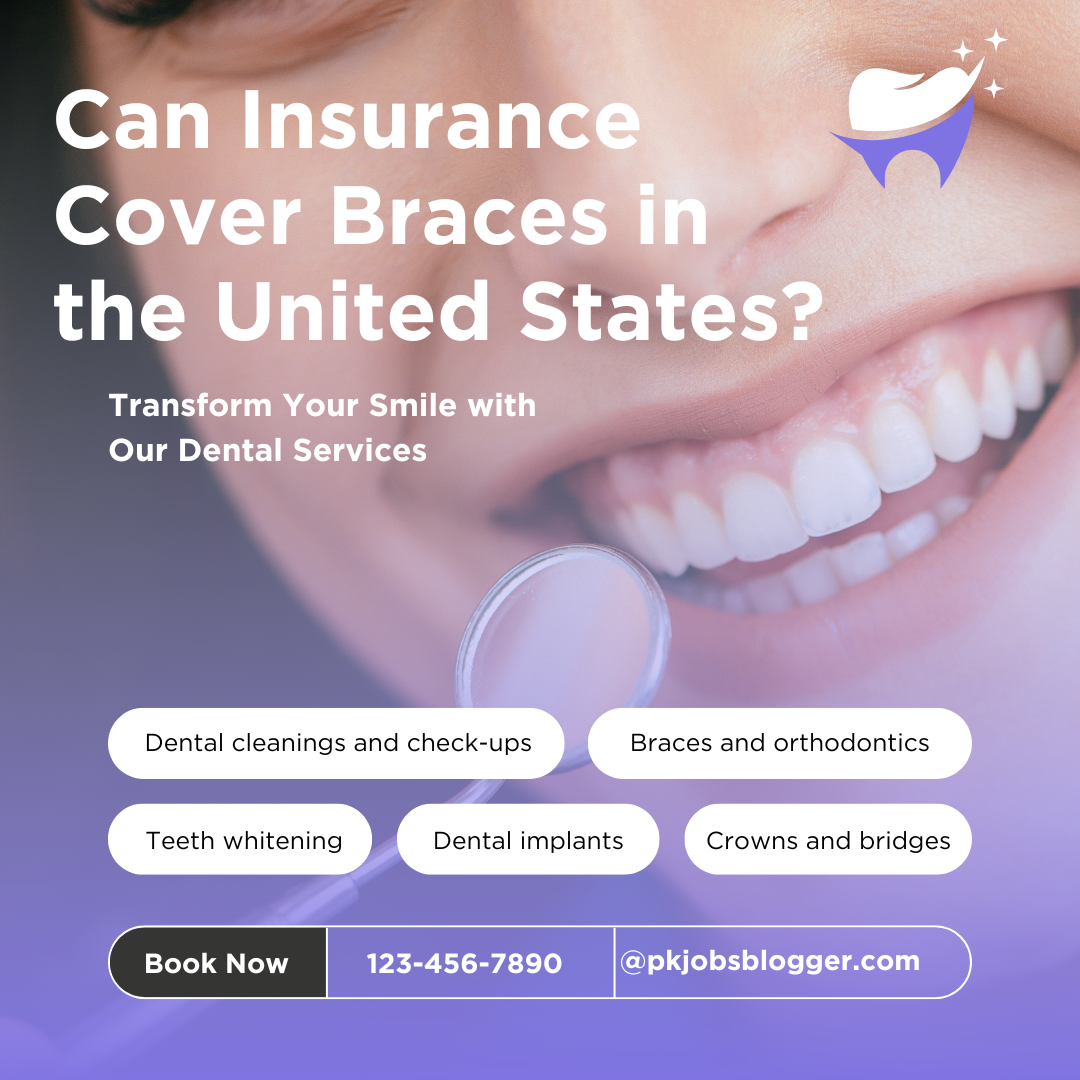Introduction
Can insurance cover braces in the United States? Getting braces is a significant step towards achieving a healthy and beautiful smile, but it often comes with a hefty price tag. Many families in the United States wonder if their insurance can help cover the cost of orthodontic treatment. Understanding how insurance works with orthodontic treatment can help in planning and managing the expenses involved. Let’s dive into the details of insurance coverage for braces and how you can navigate the complexities to make the most of your benefits.

Can Insurance Cover Braces in the United States?
Understanding Braces and Orthodontic Treatment
Types of Braces
- Conventional Metal Braces: Known for their longevity and efficiency, these braces are the most popular kind. They are also usually the least costly choice.
- Ceramic Braces: Less noticeable than metal braces, ceramic braces blend with the natural color of teeth but can be more fragile and expensive.
- Lingual Braces: Placed behind the teeth, these braces are hidden from view but are usually more costly and may not be covered by all insurance plans.
- Invisalign: These clear aligners are popular among adults and teenagers for their discreet appearance. However, they tend to be more expensive and may not always be covered by insurance.
Benefits of Braces
Braces not only improve the appearance of your smile but also enhance oral health by correcting bite issues, misaligned teeth, and jaw problems. This can prevent future dental problems and improve overall well-being.
Insurance Coverage for Braces
General Dental Insurance Overview
Most dental insurance plans provide coverage for preventative care, basic procedures, and major dental work. However, orthodontic treatment often falls under a separate category with specific limitations and requirements.
Orthodontic-Specific Insurance Plans
Some insurance plans are designed specifically to cover orthodontic treatments, including braces. These plans typically offer better coverage for orthodontic care but come with higher premiums.
Types of Dental Insurance Plans
Basic Dental Insurance Plans
Basic plans usually cover routine dental care like cleanings, exams, and minor procedures but rarely include orthodontic benefits.
Comprehensive Dental Insurance Plans
Comprehensive plans offer broader coverage, including some orthodontic treatments. They might cover a portion of the cost of braces, especially for children under a certain age.
Orthodontic Insurance Plans
Orthodontic-specific plans are designed to cover a significant portion of the cost of braces. These plans often have higher premiums and may include waiting periods and lifetime maximum benefits.
Health Insurance and Braces
Health Insurance Coverage
Health insurance plans generally do not cover braces unless they are deemed medically necessary. For instance, if braces are required to correct severe misalignment that affects eating or speaking, insurance may cover part of the cost.
Medical Necessity and Orthodontic Treatment
If an orthodontist can demonstrate that braces are medically necessary, you may have a better chance of getting health insurance to cover some of the costs. This typically requires thorough documentation and sometimes a pre-authorization.
Medicaid and CHIP Coverage
Medicaid Coverage for Braces
Medicaid may cover braces for children if they are considered medically necessary. Eligibility and coverage vary by state, so it’s essential to check with your state’s Medicaid office for specific details.
CHIP Coverage for Braces
The Children’s Health Insurance Program (CHIP) also provides coverage for braces in some states, depending on medical necessity and other criteria. Like Medicaid, CHIP coverage varies by state.
State-Specific Variations
Both Medicaid and CHIP coverage for orthodontic treatment can differ significantly from state to state. It’s crucial to understand your state’s policies and requirements to determine if your child qualifies for coverage.
How to Determine Your Coverage
Reviewing Your Insurance Policy
Carefully review your dental or health insurance policy to understand the specifics of orthodontic coverage. Look for details about coverage limits, age restrictions, and required pre-authorizations.
Consulting with Your Insurance Provider
Contact your insurance company directly to clarify coverage details. Ask about the percentage of coverage, lifetime maximum benefits, and any out-of-pocket expenses you might incur.
Getting a Pre-Treatment Estimate
Before starting treatment, ask your orthodontist to provide a detailed estimate of the costs. Submit this estimate to your insurance company to get a clear understanding of what will be covered.
Coverage Limitations and Exclusions
Common Limitations
Insurance plans often have specific limitations on orthodontic coverage, such as age restrictions, waiting periods, and lifetime maximum benefits.
Exclusions to Be Aware Of
Some plans may exclude certain types of braces, such as lingual braces or Invisalign, or may not cover orthodontic treatment for adults.

Can Insurance Cover Braces in the United States?
Cost of Braces Without Insurance
Average Costs of Different Types of Braces
- Traditional Metal Braces: $3,000 to $7,000
- Ceramic Braces: $4,000 to $8,000
- Lingual Braces: $8,000 to $10,000
- Invisalign: $4,000 to $7,500
Payment Plans and Financial Assistance
Many orthodontic offices offer payment plans to help spread the cost over time. Additionally, third-party financing options can provide loans specifically for orthodontic treatment.
Flexible Spending Accounts (FSA) and Health Savings Accounts (HSA)
Using FSA for Orthodontic Treatment
Flexible Spending Accounts allow you to use pre-tax dollars to pay for medical and dental expenses, including braces. This can reduce your overall cost by lowering your taxable income.
Using HSA for Orthodontic Treatment
Health Savings Accounts also allow you to use pre-tax dollars for medical expenses. Unlike FSAs, HSAs have no “use it or lose it” rule, making them a flexible option for funding orthodontic treatment.
Payment Plans and Financing Options
Orthodontic Office Payment Plans
Many orthodontic offices offer in-house payment plans that allow you to spread the cost of treatment over several months or years.
Third-Party Financing Options
Third-party financing companies offer loans specifically for orthodontic treatment, often with flexible payment terms and competitive interest rates.
Orthodontic Discounts and Special Offers
Discounts for Paying Upfront
Some orthodontists offer discounts if you pay for the entire treatment upfront.
Family Discounts
If multiple family members need braces, you may be able to get a discount for treating them all at the same time.
Seasonal Promotions
Orthodontic offices sometimes run promotions during certain times of the year, offering discounts or special financing terms.
Tips for Maximizing Your Insurance Benefits
Timing Your Treatment
Starting treatment at the beginning of a new insurance year can help maximize your benefits, especially if your plan has annual limits.
Choosing an In-Network Orthodontist
Using an in-network provider can reduce your out-of-pocket costs and ensure that you get the maximum benefit from your insurance plan.
Submitting Claims Effectively
Make sure to submit all required documentation and follow up with your insurance company to ensure your claims are processed correctly.
Real-Life Examples and Case Studies
Case Study 1: Coverage for a Teenager
Emily, a 14-year-old, needed braces to correct severe misalignment. Her family’s comprehensive dental plan covered 50% of the cost, up to a lifetime maximum of $1,500. The total cost of her braces was $5,000, so the insurance covered $1,500, and her family paid the remaining $3,500 out of pocket.
Case Study 2: Coverage for an Adult
John, a 35-year-old, decided to get Invisalign to correct his crowded teeth. His dental insurance did not cover adult orthodontics, so he used his FSA to cover part of the $6,500 cost. His orthodontist also offered a payment plan, allowing him to pay the remaining balance over 24 months.
Conclusion
Navigating insurance coverage for braces in the United States can be complex, but understanding your options and knowing how to maximize your benefits can make a significant difference. Whether you have comprehensive dental insurance, orthodontic-specific coverage, or are exploring other financial assistance options, there are ways to make orthodontic treatment more affordable. By being proactive and informed, you can achieve the healthy, beautiful smile you or your child deserves.
Learn More About: Can Insurance Cover Breast Reduction in the United States?
Next Post


0 Comments